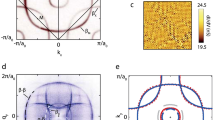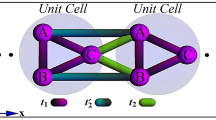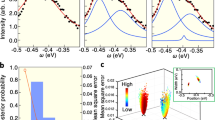Abstract
Quasiparticle lifetimes in metals as described by Fermi-liquid theory1 are essential in surface chemistry2 and determine the mean free path of hot carriers3. Relaxation of hot electrons is governed by inelastic electron–electron scattering, which occurs on femtosecond timescales owing to the large scattering phase space competing with screening effects4. Such lifetimes are widely studied by time-resolved two-photon photoemission5,6, which led to understanding of electronic decay at surfaces6,7,8. In contrast, quasiparticle lifetimes of metal bulk5,9,10,11,12 and films11,13,14,15 are not well understood because electronic transport10,16,17 leads to experimental lifetimes shorter than expected theoretically13,15,18. Here, we lift this discrepancy by investigating Pb quantum-well structures on Si(111), a two-dimensional model system19,20,21,22,23,24,25,26,27,28,29. For electronic states confined to the film by the Si bandgap we find quantitative agreement with Fermi-liquid theory and ab initio calculations4,7 for bulk Pb, which we attribute to efficient screening. For states resonant with Si bands, extra decay channels open for electron transfer to Si, resulting in lifetimes shorter than expected for bulk. Thereby we demonstrate that for understanding electronic decay in nanostructures coupling to the environment is essential, and that even for electron confinement to a few ångströms Fermi-liquid theory for bulk can remain valid.
This is a preview of subscription content, access via your institution
Access options
Subscribe to this journal
Receive 12 print issues and online access
$259.00 per year
only $21.58 per issue
Buy this article
- Purchase on SpringerLink
- Instant access to full article PDF
Prices may be subject to local taxes which are calculated during checkout
 point observed by photoemission.
point observed by photoemission.



Similar content being viewed by others
References
Giuliani, G. F. & Vignale, G. Quantum Theory of the Electron Liquid (Cambridge Univ. Press, 2005).
Zhu, X-Y. Electronic structure and electron dynamics at molecule–metal interfaces: Implications for molecule-based electronics. Surf. Sci. Rep. 56, 1–83 (2004).
Kliewer, J. et al. Dimensionality effects in the lifetime of surface states. Science 288, 1399–1402 (2000).
Chulkov, E. V. et al. Electronic excitations in metals and at metal surfaces. Chem. Rev. 106, 4160–4206 (2006).
Petek, H. & Ogawa, S. Femtosecond time-resolved two-photon photoemission studies of electron dynamics in metals. Prog. Surf. Sci. 56, 239–310 (1997).
Weinelt, M. Time-resolved two-photon photoemission from metal surfaces. J. Phys. Condens. Mater. 14, R1099–R1141 (2002).
Echenique, P. M. et al. Decay of electronic excitations at metal surfaces. Surf. Sci. Rep. 52, 219–317 (2004).
Güdde, J., Rohleder, M., Meier, T., Koch, S. W. & Höfer, U. Time-resolved investigation of coherently controlled electric currents at a metal surface. Science 318, 1287–1291 (2007).
Schmuttenmaer, C. A. et al. Time-resolved two-photon photoemission from Cu(100): Energy dependence of electron relaxation. Phys. Rev. B 50, 8957–8960 (1994).
Knoesel, E., Hotzel, A. & Wolf, M. Ultrafast dynamics of hot electrons and holes in copper: Excitation, energy relaxation, and transport effects. Phys. Rev. B 57, 12812–12824 (1998).
Cao, J., Gao, Y., Elsayed-Ali, H. E., Miller, R. J. D. & Mantell, D. A. Femtosecond photoemission study of ultrafast electron dynamics in single-crystal Au(111) films. Phys. Rev. B 58, 10948–10952 (1998).
Gerlach, A. et al. Lifetime of d holes at Cu surfaces: Theory and experiment. Phys. Rev. B 64, 085423 (2001).
Ogawa, S., Nagano, H. & Petek, H. Optical intersubband transitions and femtosecond dynamics in Ag/Fe(100) quantum wells. Phys. Rev. Lett. 88, 116801 (2002).
Wegner, D., Bauer, A. & Kaindl, G. Electronic structure and dynamics of quantum-well states in thin Yb metal films. Phys. Rev. Lett. 94, 126804 (2005).
Zhukov, V. P. et al. Excited electron dynamics in bulk ytterbium: Time-resolved two-photon photoemission and GW+T ab initio calulations. Phys. Rev. B 76, 193107 (2007).
Aeschlimann, M. et al. Transport and dynamics of optically excited electrons in metals. Appl. Phys. A 71, 485–491 (2000).
Lisowski, M., Loukakos, P. A., Bovensiepen, U. & Wolf, M. Femtosecond dynamics and transport of optically excited electrons in epitaxial Cu films on Si(111)-7×7. Appl. Phys. A 79, 739–741 (2004).
Bauer, M., Pawlik, S. & Aeschlimann, M. Electron dynamics of aluminum investigated by means of time-resolved photoemission. Proc. SPIE 3272, 201–210 (1998).
Wei, C. M. & Chou, M. Y. Theory of quantum size effects in thin Pb(111) films. Phys. Rev. B 66, 233408 (2002).
Guo, Y. et al. Superconductivity modulated by quantum size effects. Science 306, 1915–1917 (2004).
Upton, M. H., Wei, C. M., Chou, M. Y., Miller, T. & Chiang, T-C. Thermal stability and electronic structure of atomically uniform Pb films on Si(111). Phys. Rev. Lett. 93, 026802 (2004).
Zhang, Y-F. et al. Band structure and oscillatory electron–phonon coupling of Pb thin films determined by atomic-layer-resolved quantum-well states. Phys. Rev. Lett. 95, 096802 (2005).
Dil, J. H., Kim, J. W., Kampen, T., Horn, K. & Ettema, A. R. H. F. Electron localization in metallic quantum wells: Pb versus In on Si(111). Phys. Rev. B 73, 161308 (2006).
Kirchmann, P. S., Wolf, M., Dil, J. H., Horn, K. & Bovensiepen, U. Quantum size effects in Pb/Si(111) investigated by laser-induced photoemission. Phys. Rev. B 76, 075406 (2007).
Shanenko, A. A., Croitoru, M. D. & Peeters, F. M. Oscillations of the superconducting temperature induced by quantum well states in thin metallic films: Numerical solution of the Bogoliubov–de Gennes equations. Phys. Rev. B 75, 014519 (2007).
Hong, I-P. et al. Decay mechanisms of excited electrons in quantum-well states of ultrathin Pb islands grown on Si(111): Scanning tunneling spectroscopy and theory. Phys. Rev. B 80, 081409 (2009).
Qin, S., Kim, J., Niu, Q. & Shih, C-K. Superconductivity at the two-dimensional limit. Science 324, 1314–1317 (2009).
Brun, C. et al. Reduction of the superconducting gap of ultrathin Pb islands grown on Si(111). Phys. Rev. Lett. 102, 207002 (2009).
Zhang, T. et al. Superconductivity in one-atomic-layer metal films grown on Si(111). Nature Phys. 6, 104–108 (2010).
Kirchmann, P. S. & Bovensiepen, U. Ultrafast electron dynamics in Pb/Si(111) investigated by two-photon photoemission. Phys. Rev. B 78, 035437 (2008).
Kawakami, R. K. et al. Quantum-well states in copper thin films. Nature 398, 132–134 (1999).
Paggel, J. J., Miller, T. & Chiang, T-C. Quantum-well states as Fabry–Pérot modes in a thin-film electron interferometer. Science 283, 1709–1711 (1999).
Acknowledgements
We thank C. Brun for discussions and acknowledge support from and discussions with M. Wolf. This work has been funded by the Deutsche Forschungsgemeinschaft through BO 1823/2 and by the Ministerio de Ciencia y Tecnologia (grant FIS2007-66711-C02-01). P.S.K. acknowledges support by the International Max-Planck Research School ‘Complex Surfaces in Material Science’.
Author information
Authors and Affiliations
Contributions
P.S.K. and L.R. carried out the experiments and analysed the data; U.B. designed and coordinated the experiment; X.Z. and V.M.S. carried out the calculations; P.S.K., U.B., and E.V.C. wrote the paper; all authors commented on the manuscript.
Corresponding author
Ethics declarations
Competing interests
The authors declare no competing financial interests.
Supplementary information
Supplementary Information
Supplementary Information (PDF 347 kb)
Rights and permissions
About this article
Cite this article
Kirchmann, P., Rettig, L., Zubizarreta, X. et al. Quasiparticle lifetimes in metallic quantum-well nanostructures. Nature Phys 6, 782–785 (2010). https://doi.org/10.1038/nphys1735
Received:
Accepted:
Published:
Issue date:
DOI: https://doi.org/10.1038/nphys1735
This article is cited by
-
Interplay between the atomic structures and superconductivity of two-monolayer Pb films
Science China Physics, Mechanics & Astronomy (2024)
-
Quantum-well states at the surface of a heavy-fermion superconductor
Nature (2023)
-
Quantum size effect on charges and phonons ultrafast dynamics in atomically controlled nanolayers of topological insulators Bi2Te3
Scientific Reports (2017)
-
Energy dissipation from a correlated system driven out of equilibrium
Nature Communications (2016)



